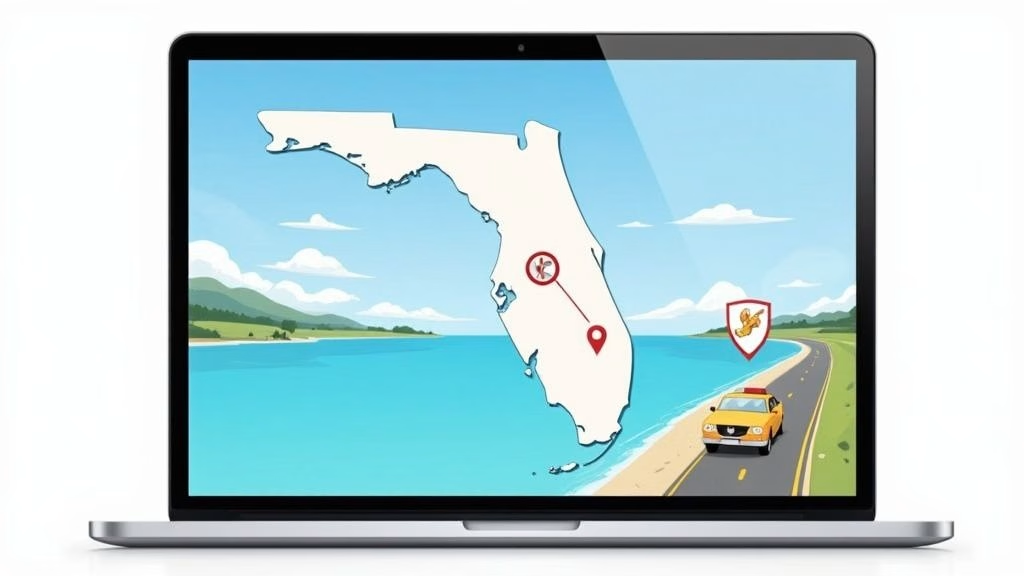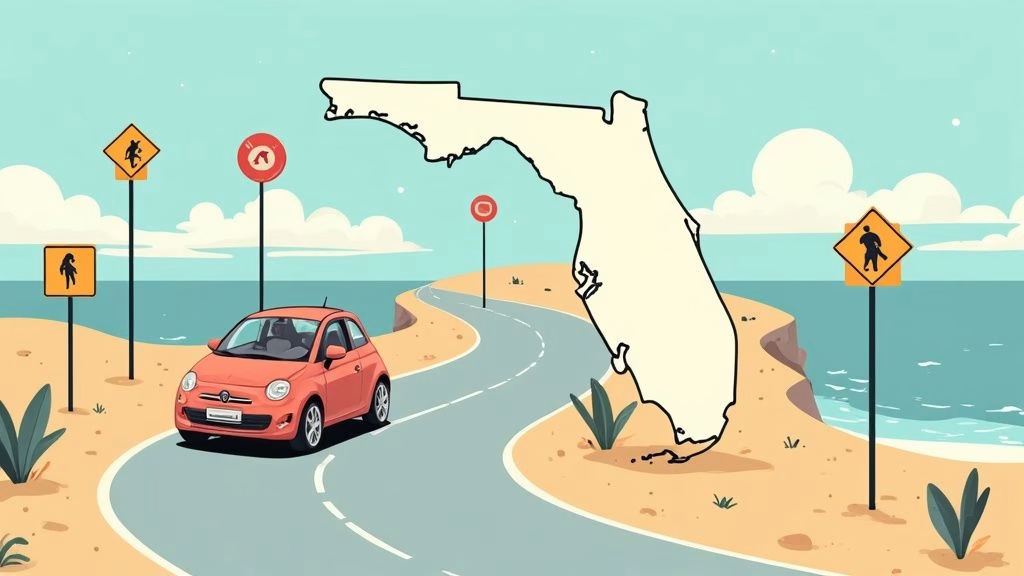Self-paced online courses are exactly what they sound like: educational programs you can take on your own time. Forget about fixed class schedules and strict deadlines. Instead of a rigid group fitness class held at the same time every week, think of it as a personal training app that works around your life. This model gives you complete control over when, where, and how you learn.
Understanding the World of Self-Paced Online Courses
Have you ever wanted to learn something new, but the only classes offered were at 8 AM on a Tuesday, smack in the middle of your most important weekly meeting? Traditional education has always demanded that we bend our lives to fit its schedule. Self-paced learning completely flips that around, putting you firmly in the driver’s seat.
This learning style is often called asynchronous learning. In simple terms, it means all the course materials�from video lectures to reading assignments and quizzes�are ready and waiting for you from day one. There are no live lectures you have to tune into or mandatory group sessions. You get to decide if you want to study on your lunch break, late at night after the kids are in bed, or by blocking out a whole weekend to dive deep into a topic.
The Core Idea: Learner Autonomy
The real power behind self-paced online courses is learner autonomy. This goes way beyond just a flexible schedule. It�s about shaping the entire learning process to fit your specific needs and preferences. You get to:
- Set Your Own Pace: Breeze through the stuff you already know and take your time on the tougher concepts. You�ll never feel rushed by a group or held back waiting for others to catch up.
- Choose Your Learning Environment: Your classroom is wherever you want it to be. Settle in at your home office, a bustling coffee shop, or even on the train during your commute.
- Fit Education Into Your Life: You no longer have to make the tough choice between getting ahead in your career and managing your personal life. This model lets you weave learning into your existing routine.
This level of control is a game-changer for so many people. Busy professionals can pick up new skills without missing work. Parents can study around their family�s schedule. Students can juggle a part-time job and still hit the books. This flexibility is also perfect for things like completing a state-approved BDI course on your own timeline. You can check out all the benefits of an online driving school to see how this works in a real-world scenario.
The Massive Shift Toward Flexible Learning
The move to this kind of education isn’t a small trend�it’s a global phenomenon. As the job market keeps changing, the demand for accessible, flexible ways to learn new skills has absolutely exploded.
The global embrace of self-paced learning has been nothing short of dramatic. Coursera, one of the biggest online platforms, saw its user base leap from 21 million in 2016 to an incredible 92 million in 2021. That�s not just growth; it�s a fundamental shift in how people view education.
The pandemic certainly threw gas on the fire, pushing millions into remote work and forcing them to find new ways to learn from home. In 2021 alone, Coursera added over 20 million new learners�the same number it gained in the three previous years combined. You can dig deeper into this trend by reading about online learning’s global impact. The data tells a clear story: self-paced education is no longer just an alternative; it’s the first choice for millions around the world.
The Real Benefits of Learning On Your Schedule
Flexibility is the big buzzword with self-paced courses, but what does that actually look like day-to-day? It�s not just about convenience. It�s about fitting education into the nooks and crannies of your real life, instead of blowing up your schedule to accommodate a class.
Think about a new parent. The only real quiet time might be after the baby goes down for the night, maybe around 10 PM. With a self-paced course, those late-night hours become productive study time. Or maybe you’re a working professional chasing a promotion. You can knock out a lesson or two on your lunch break without having to sacrifice evening family time. That�s what real flexibility means�learning when you’re ready, not when a calendar tells you to be.
This kind of control really takes the pressure off. No more stressing about traffic to get to a campus or trying to keep pace with classmates who have totally different schedules. You get to focus on actually learning the material, not just scrambling to meet deadlines.
A Learning Path Designed For You
Beyond the schedule, self-paced learning lets you personalize the way you learn. In a traditional classroom, everyone is stuck on the same train, moving at the same speed. When you’re in control, you become the conductor.
If you�re already familiar with a topic, you can breeze right through it. But if you hit a section that�s a bit tricky, you have the freedom to pump the brakes. You can re-read the material, watch a video again, or work through an example a few more times until it clicks.
- Mastery Over Memorization: You can spend extra time on the tough stuff, making sure you actually understand it before moving on.
- Efficient Use of Time: No more sitting through lectures on things you already know just to get to the new material.
- Increased Confidence: There’s a real sense of accomplishment that comes from working through a tough concept on your own terms. It builds self-assurance and makes the knowledge stick.
This approach is all about gaining a much deeper, more solid understanding. The goal shifts from just checking off assignments to truly mastering the subject.
Self-Paced vs Instructor-Led Courses Compared
To really understand the difference, it helps to see the two main online course models side-by-side. One gives you total control, while the other provides more structure.
| Feature | Self-Paced Online Course | Instructor-Led Online Course |
|---|---|---|
| Schedule | Completely flexible; start and finish on your own timeline. | Fixed schedule with set start/end dates and assignment deadlines. |
| Pacing | Learn as quickly or slowly as you need. | Everyone follows the same weekly pace set by the instructor. |
| Interaction | Primarily with the course material; support is often via email or forums. | Regular interaction with instructors and classmates through live sessions or discussion boards. |
| Best For | Independent learners, busy professionals, or those with unpredictable schedules. | Learners who thrive on structure, deadlines, and group collaboration. |
Ultimately, neither is “better”�they just serve different needs. The key is knowing which style works best for your life and learning habits.
Cost-Effectiveness and Career Impact
The financial upsides of self-paced learning are pretty significant. Right off the bat, you save money by cutting out commute costs like gas, bus fare, and parking. You also don’t have to buy expensive physical textbooks, since most resources are built right into the course digitally.
The economic impact isn’t just personal; it’s global. The self-paced e-learning market pulled in around USD 125 billion recently and is on track to hit a staggering USD 374 billion. That explosive growth is a clear sign that people are hungry for affordable, skill-focused education they can tackle on their own time.
This trend shows just how many people are using these courses to get ahead in their careers. By picking up new skills without breaking the bank or quitting their job, they become stronger candidates for a promotion or a new role. Even taking a course for personal reasons, like a defensive driving class, can pay off. If you�re wondering about that, check out our guide on whether a defensive driving class can lower your insurance.
The chart below captures just how massive this shift to online learning has become.

This isn�t just a fad. It�s a fundamental change in how we approach education and build our careers.
Overcoming Common Self-Study Hurdles

The freedom of a self-paced online course is its biggest selling point, but let�s be honest�it can also be its biggest challenge. When there�s no professor handing out deadlines and no classmates saving you a seat, all the responsibility lands squarely on you. It’s a bit like being handed the keys to a car with a full tank of gas and a map. The destination is clear, but you�re the one who has to do the driving.
The toughest obstacles usually come from within. Procrastination, a dwindling sense of motivation, and even feelings of isolation can trip up even the most dedicated student. The good news is, these aren’t dead ends. They’re just bumps in the road you can navigate with the right strategies.
Taming Procrastination with Structure
That nagging little voice that says “I’ll do it later” is the arch-nemesis of any self-paced learner. The most effective way to fight it is by creating a simple, repeatable structure that makes starting your work feel easier than putting it off. Vague intentions like “I’ll study this week” are just asking to be ignored. You have to get specific.
- Block Out Study Time: Treat your coursework like an important meeting you can’t miss. Schedule 60- or 90-minute blocks directly into your calendar and guard that time fiercely.
- Set Micro-Goals: Instead of a daunting goal like “Finish the module,” break it down. Aim to “watch two videos and do one quiz.” These small, achievable wins are what build real momentum.
- Use the 5-Minute Rule: If you�re really struggling to get started, just commit to five minutes. That�s it. You’ll almost always find that getting over that initial hump is the hardest part.
Suddenly, that massive mountain you had to climb becomes a series of manageable steps.
Fueling Your Motivation for the Long Haul
Keeping that fire lit when you’re the only one in the room is a different ballgame. Without external pressure, you have to find your own internal drive. This is where it gets personal.
Convenience is king�a whopping 90% of learners choose online courses for that reason. But here’s the catch: studies reveal that only 49% of them find the experience consistently engaging and motivating.
This shows there’s a huge gap between starting and finishing. Convenience gets you in the door, but it�s your personal motivation that will get you across the finish line.
So, how do you stay in that motivated half? You have to constantly reconnect with your “why.” Why did you sign up for this course in the first place? Was it to clear points from your driving record, get a leg up at work, or learn a skill you’ve always been curious about? Keep that reason front and center. It’s your best defense against burnout. You can dive deeper into what makes online learners tick with these comprehensive eLearning statistics.
Conquering the Feeling of Isolation
Studying on your own schedule doesn’t have to mean you�re completely alone. That feeling of being on an island is a common hurdle, but it’s one you can overcome by intentionally building connections.
- Engage in Course Forums: If your course has a discussion board, use it. Don’t just be a passive reader�jump in, ask questions, and share what you’ve learned. You�d be surprised how many others have the same questions you do.
- Find a Study Buddy: See if a friend or colleague is taking a similar course. Just having someone to check in with can make a world of difference for accountability.
- Use Social Media Groups: Platforms like LinkedIn and Reddit are filled with communities dedicated to specific topics. Sharing your journey and learning from others can make the whole process feel much less solitary.
By actively creating a support network, you can get some of that classroom camaraderie back, making your independent learning journey both successful and a lot more enjoyable.
How to Choose the Right Self-Paced Course
With so many self-paced online courses out there, picking the right one can feel like a shot in the dark. It�s a bit like standing in a massive library where every book cover screams that it holds the key to your success. How do you find the real gems? You need a solid game plan to sort the good from the bad.
This means looking beyond the slick marketing and bold promises. A truly great course stands on a foundation of three things: quality content, a credible instructor, and official recognition. If any of these are missing, you could waste your time and money on a program that won’t get you where you need to go.
Vet the Course Content and Structure
First things first, you have to play detective with the curriculum. A well-designed course will have a detailed and transparent syllabus, basically giving you a clear roadmap of what you’ll be learning from start to finish. You want to see a logical flow where each topic builds on the last, not just a random collection of videos thrown together.
Vague module descriptions are a huge red flag. If a course promises to teach you “marketing fundamentals” but doesn’t actually list specifics like SEO, content strategy, or analytics, you should be wary. The best courses are proud of their content and aren’t afraid to show you exactly what’s inside.
But it�s not just what you learn; it�s how you learn. Does the course just have you passively watching videos for hours on end, or does it actually get you involved? Look for active learning elements.
- Interactive Quizzes: These are great for making sure you’re actually absorbing the material.
- Practical Assignments: Projects or case studies force you to apply what you�ve learned in a real-world context.
- Downloadable Resources: Things like checklists, templates, and guides are incredibly valuable long after the course is over.
A course that keeps you engaged is one where the lessons will actually stick.
Assess Instructor Credibility and Support
The person teaching the course is everything. Their expertise�or lack thereof�is the backbone of your entire learning experience. So, do a little digging. A quick online search should tell you about their professional background, their real-world experience, and what past students think of their teaching style. An expert who has actually done the work is always a better teacher than someone who just knows the theory.
Just as important is the kind of support you�ll get. “Self-paced” shouldn’t mean you’re left completely alone. What happens when you hit a roadblock?
A key differentiator for quality self-paced online courses is the support system. While some offer nothing more than a basic FAQ page, better programs provide access to instructor office hours, active student forums, or dedicated email and chat support.
Having that safety net can be the difference between finishing strong and giving up when things get tough.
Check for Accreditation and Official Recognition
For certain subjects, official recognition isn’t just a nice-to-have; it’s a must. This is especially true for any course that’s meant to fulfill a professional or legal requirement. Think of accreditation as a seal of approval from a recognized authority, confirming that the course meets tough quality standards.
For example, if you’re taking a course for a professional certification, you need to make sure the program is an authorized provider. The same goes for state-mandated training. This is a big deal for drivers in Florida who need to complete a Basic Driver Improvement (BDI) course. Choosing a state-approved program is the only way to ensure the certificate you get will be accepted by the courts and the DMV. You can find out more about what to look for by reviewing details on an approved online traffic school.
Before you pull the trigger and enroll, run through this quick checklist. It will help you cut through the noise and make a decision you feel good about.
Your Course Selection Checklist
| Evaluation Criteria | What to Look For | Red Flags |
|---|---|---|
| Content Depth | A detailed, transparent syllabus with clear learning objectives. | Vague module descriptions or a disorganized curriculum. |
| Instructor Expertise | Verifiable real-world experience and positive teaching reviews. | No professional background info or an instructor who is hard to find online. |
| Accreditation | Official approval from state bodies or industry organizations. | No mention of accreditation or unverifiable claims of approval. |
| Student Reviews | Recent, detailed reviews on third-party sites discussing specific pros and cons. | Only perfect, generic reviews on the course’s own website. |
| Platform Usability | A clean, intuitive interface that is easy to navigate on any device. | A clunky, outdated platform that looks difficult to use. |
Taking a few minutes to evaluate these points can save you a lot of headaches down the road and ensure you invest in a course that truly delivers.
Proven Strategies for Online Learning Success

Signing up for a self-paced online course is the easy part. The real secret to success is building the right habits from the get-go. The freedom these courses offer is fantastic, but it also means you�re in the driver’s seat�and you need to be disciplined.
Think of it like being your own personal trainer. You’re responsible for setting the pace, staying motivated, and celebrating your progress. Without a solid game plan, it’s all too easy to let things slide. The students who truly thrive are the ones who create their own structure and accountability, turning that flexibility into their biggest advantage.
Create Your Personal Learning Blueprint
The bedrock of success in a self-paced world is a plan. A vague goal like “I’ll get to it this week” is a recipe for procrastination. You have to get specific.
Start by looking at the whole curriculum and breaking it down into bite-sized pieces. Instead of feeling overwhelmed by the thought of finishing the entire course, set a small, achievable weekly goal. For example, aim to “Complete two video lessons and one quiz by Wednesday.” This approach gives you a series of small wins that keep you motivated and moving forward.
A consistent study schedule is your best friend. While flexibility is great, carving out specific, non-negotiable times each week�even if it’s just a few hours�turns studying into a powerful habit rather than an afterthought.
Treat these study blocks like you would any important appointment. Whether it’s an hour every morning or a couple of dedicated sessions on the weekend, that consistency is what will carry you across the finish line.
Engineer a Distraction-Free Study Zone
Where you study matters. A lot. Trying to learn on the couch with the TV blaring in the background just doesn’t work. To really absorb new information, you need a space that tells your brain it’s time to focus.
You don’t need a fancy home office. A few simple tweaks can make a massive difference:
- Silence the Noise: Use website blockers or just put your phone on silent and in another room. Those constant pings from social media are productivity killers.
- Keep It Tidy: A cluttered desk often leads to a cluttered mind. Keep your space organized with only the materials you actually need for the task at hand.
- Set Boundaries: Let your family or roommates know your study schedule to minimize interruptions.
A popular trick for staying sharp is the Pomodoro Technique. You work in a super-focused sprint for 25 minutes, then take a short 5-minute break. After four rounds, you take a longer break. It�s a simple but effective way to prevent burnout and keep your concentration high.
Engage Actively with the Material
Just watching videos or scrolling through text is passive learning, and it’s one of the least effective ways to make information stick. You have to get your hands dirty and actively engage with the content.
This is especially true for courses where remembering the details is critical, like when you�re taking a defensive driving course online. You want those traffic laws to be second nature when you need them.
Here�s how to turn passive viewing into active learning:
- Take Your Own Notes: Don’t just copy what’s on the screen. Put concepts into your own words. This forces your brain to process the information on a deeper level.
- Apply What You’ve Learned: Look for ways to use your new knowledge. If you’re learning a new skill, try a small project. If it’s a theory, try explaining it to someone else.
- Join the Conversation: If your course has a discussion forum, jump in! Asking questions and helping others is a great way to solidify what you know.
To really get the most out of your time, it’s worth exploring different learning methods. Resources like these 10 Supercharged Student Learning Strategies can introduce you to powerful new techniques. Even adding one or two to your routine can make a huge difference in how well you learn and remember.
The Future of Flexible and Personal Education
The move toward self-paced online courses isn’t just a fleeting trend. It’s a genuine shift in how we think about learning and growing throughout our careers. We’re finally leaving behind the old one-size-fits-all classroom model and entering an era where education molds itself to the individual, not the other way around.
New technology is only going to supercharge this. Picture a course that instantly recognizes when you’ve mastered a topic and speeds up, but then offers extra resources the moment you start to struggle. That�s the potential of AI-driven learning paths�it’s like having a personal tutor built right into the course.
Key Trends Shaping Tomorrow’s Learning
This evolution is picking up steam, pushed forward by a few key developments that are making learning more connected and engaging. These aren�t sci-fi concepts; they’re happening right now.
- The Rise of Micro-Credentials: The four-year degree is no longer the only game in town. The future is all about micro-credentials�small, focused certifications that prove you have a specific, in-demand skill. In fact, one report found that a staggering 70% of employees would think about leaving their current job for one that invested more in their development, and these credentials are a perfect way to do that.
- Immersive Learning with VR and AR: Virtual and augmented reality are starting to erase the line between online and hands-on learning. Imagine practicing a delicate surgical procedure in a virtual lab or taking a tour of ancient Rome from your couch. This tech is making online learning more tangible and memorable than ever before.
Embracing a Lifestyle of Continuous Growth
This new way of learning is about more than just fitting a class into your busy schedule; it’s about taking control. The freedom of self-paced education fits perfectly with modern goals and lifestyles. Think about the growing number of people who use online courses to learn skills that let them figure out how to work remotely and travel the world. It puts you in the driver’s seat of your own career path.
The ability to learn on your own terms is the ultimate professional advantage. It empowers you to stay relevant in a rapidly changing job market, pivot your career when you choose, and continuously invest in your most important asset: yourself.
Learning is a journey without a finish line. When you embrace self-paced online courses, you aren’t just enrolling in a class. You’re making a commitment to a future where your potential for growth is truly limitless.
Frequently Asked Questions
Jumping into the world of self-paced online learning can feel exciting, but it’s natural to have a few questions. When you’re weighing your options, getting straight answers to those nagging “what ifs” is key.
Let’s tackle some of the most common questions people have. We’ll cover everything from what employers really think to what happens when you hit a wall with a tough lesson.
Are Self-Paced Online Courses Credible with Employers?
Absolutely. What employers care about most are the skills you can prove you have, not necessarily how you learned them. A completed self-paced course shows them you’ve got initiative, self-discipline, and a real drive to grow�all qualities that look great on a resume.
Courses that lead to recognized industry certifications or fulfill official state requirements, like a driver improvement program, carry a lot of weight. The trick is to do your homework. Always check for accreditation, read recent student reviews, and make sure the provider is well-regarded before you sign up.
How Long Do You Have to Complete a Self-Paced Course?
This really depends on the course. Some providers offer lifetime access, which is great for a resource you might want to refer back to for years. More often, though, you�ll see access periods ranging from three months to a full year.
This timeframe is often a sweet spot. It gives you plenty of flexibility to fit the learning into your life without letting it drag on forever, providing a little nudge to keep you moving toward the finish line.
Always look for the access period in the course description before you enroll. You want to make sure the timeline works with your schedule so there are no surprises later on.
What Kind of Support Is Available If I Get Stuck?
Support can make or break an online learning experience. Some bare-bones courses might just have a simple FAQ page, leaving you to figure things out on your own. But the best self-paced online courses have solid support systems built in so you never feel isolated.
Look for features like:
- Student Community Forums: A great place to post questions and see how other students have solved similar problems.
- Instructor Office Hours: Scheduled video calls or chats where you can talk directly to the expert.
- Dedicated Email or Chat Support: Quick access to teaching assistants or support staff who can help you get unstuck.
When you’re comparing courses, pay close attention to the support options. Having a reliable safety net is a huge advantage, especially when you’re tackling a complex topic.
Ready to take control of your learning with a flexible, state-approved program? At BDISchool, our Florida Basic Driver Improvement course is fully online and self-paced, allowing you to learn on your schedule. Find out more at https://bdischool.com.





![The Best Online Traffic Schools in Florida [2025]](https://floridanewdriver.com/wp-content/uploads/emplibot/online-traffic-school-florida-hero-1765422499.avif)

